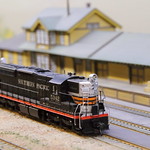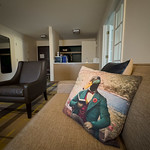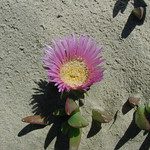BRUSH POPPERS OF THE CENTRAL COASTINC
ARROYO GRANDE, CA

Brush Poppers of the Central Coast, Inc. is a full-service tree service company located in Arroyo Grande, California. Founded in 1987, Brush Poppers has over 30 years of experience in providing tree services to the Central Coast area. They specialize in tree trimming, tree removal, stump grinding, root pruning, and firewood harvesting.
Brush Poppers staff is highly experienced and are certified arborists. They are also members of the International Society of Arboriculture (ISA). They employ modern techniques to ensure that their services are safe and efficient. They use the latest equipment to quickly and safely complete each job.
Brush Poppers also offers emergency tree care services. They are available 24/7 to provide assistance in case of hazardous trees or if any tree needs immediate attention. They can also provide tree care consultation services to help customers manage their trees effectively.
Brush Poppers of the Central Coast, Inc. is committed to providing quality services and ensuring customer satisfaction. They hold a C-61/D49 license, which is the highest and most comprehensive license for tree service providers in California. They are also fully insured and bonded, providing customers with additional peace of mind.
Brush Poppers of the Central Coast, Inc. is dedicated to providing the best tree service in the Central Coast area. Their knowledgeable staff, quality services, and customer satisfaction are what make them the top choice for tree care services.
BRUSH POPPERS OF THE CENTRAL COASTINC is a History Museum in ARROYO GRANDE CA. US MID #8400600802
The museum is classed as HST (History Museums). It comes under American Alliance of Museums (AAM) region: Western (Alaska, Arizona, California, Hawaii, Idaho, Nevada, Oregon, Utah, Washington).
Contact BRUSH POPPERS OF THE CENTRAL COASTINC
BRUSH POPPERS OF THE CENTRAL COASTINC
PO BOX 184
ARROYO GRANDE
CA
93421-0184
Disclaimer: please note this database is maintained by volunteers and whilst we endeavour to do our best, we cannot guarantee the accuracy of the listing.
If you notice any errors or omissions in the listing, please let us know in the comments section below.
Find more ARROYO GRANDE CA Museums
What 3 Words
///exchanges.menu.clues. Near Arroyo Grande, California
Map of BRUSH POPPERS OF THE CENTRAL COASTINC
BRUSH POPPERS OF THE CENTRAL COASTINC Information
| MID # | 8400600802 |
| Name | BRUSH POPPERS OF THE CENTRAL COASTINC |
| Alternate Name | |
| Classification | History Museums, , Western |
| Federal Employer Identification Number (EIN) | 205221247 |
| NTEECC | A54 |
| Tax period of the latest return filed (YYYYMM) | 201212 |
| INCOME | 0 |
| REVENUE | 0 |
| LAT/LONG | 35.104264, -120.59163 |
| CODES | FIPS State Code: 06 FIPS County Code: 079 US Census Tract: 011901 US Census Block: 2026 |




![Pismo Pier from the Cliffs at Shell Beach Pismo Beach (Chumash: Pismuʔ) is a city in the southern portion of San Luis Obispo County, in the Central Coast area of California, United States.[10] Its estimated population was 8,072 at the 2020 census, up from 7,655 in the 2010 census. It is part of the Five Cities area, a cluster of cities in that area. The Five Cities area historically is made up of Arroyo Grande, Grover City (now Grover Beach), Halcyon, Fair Oaks, and Nipomo. Now most people refer to the Five Cities as Grover Beach, Pismo Beach, Shell Beach (which is actually a part of Pismo Beach), Arroyo Grande, and Oceano (which is unincorporated county land serviced by the Oceano Community Services District).
History
Pismo Pier at sunset
The old Oilport Refinery, demolished after WWII, is now the Sunset Palisades neighborhood.
The Chumash people are the historic inhabitants of the region, with indigenous peoples having lived along the California coast for at least 11,000 years.[11] The name Pismo comes from the Chumash language word for tar, pismuʔ,[2] which was gathered from tar springs in Price Canyon near Pismo Beach. The tar was a valuable product, which the Chumash used to caulk their seagoing canoes, called tomol, which traveled along the coast and out to the Channel Islands. The first European land exploration of Alta California, the Spanish Portolá expedition, passed through the area, traveling up Price Canyon from Pismo Beach, where they camped on September 4, 1769. Franciscan missionary and expedition member Juan Crespí noted in his diary that they found a Chumash village near the creek.[12][13]
Pismo Beach is located on the Rancho Pismo Mexican land grant made to José Ortega, grandson of José Francisco Ortega, in 1840. In 1846, José Ortega sold Rancho Pismo to Isaac Sparks. John Michael Price bought most of the rancho from Sparks. Price established the town of Pismo Beach in 1891. His homestead is now Price Historical Park.[14] His home is a registered historical landmark. Pismo is known as the clam capital of the world.[citation needed] Nearly over 2.5 million people visit Pismo Beach.
The first wharf at Pismo was built in 1882, followed by a full-length pier built in 1924 that was financed and constructed by William Woodrow Ward, who allowed full use of it by the public. After it suffered considerable storm damage, the pier was renovated again in 1985. Pismo State Beach is named for the city of Pismo Beach.
The neighborhoods of Shell Beach and Sunset Palisades were the site of a Chumash village, and significant archeological sites are located in both areas. Shell Beach became agricultural land, mostly pea fields. Developer Floyd Calvert bought and developed the area in 1926. At first, it was a local resort area; after World War II, it became primarily residential. Sunset Palisades, originally called Oilport, was the site of an oil refinery from 1907 until after World War II; it is now residential.[15]
Clams
The Pismo clam was named for the long, wide beach where so many were once found, once in such abundance that they were harvested with plows. Clamming once drew thousands of clammers to Pismo during low tides, and is still legal, but due to overharvesting by humans and the protected sea otter (which feasts on clams), few clams are now to be found.[16]
Pismo Beach adopted the name "Clam Capital of the World" in the 1950s, though this motto is no longer used. The city still holds the Clam Festival every October, complete with clam chowder competitions and a clam-themed parade.[17]
At the southern end of Price Street upon first entering Pismo Beach is a gigantic concrete clam statue. The eight-inch (20 cm) shell of a Pismo clam (Tivela stultorum) is on display at the Pismo Beach Chamber of Commerce.
Geography
External videos
video icon Panoramic Video of Pismo Beach on YouTube
According to the United States Census Bureau, the city has a total area of 13.5 square miles (35 km2), of which 9.9 square miles (26 km2) (73.29%) is covered by water.
Pismo Creek enters the Pacific Ocean at Pismo Beach.[18] The southern end of Pismo Beach runs alongside sand dunes, which are followed by eucalyptus trees that attract thousands of migrating monarch butterflies every November through February.[10]
Meadow Creek is a short creek that runs through the Pismo Lake Ecological Reserve and hosts a variety of wildlife despite its urban surroundings, including beaver (Castor canadensis).[19][20][21][22]
Climate
Pismo Beach has a warm-summer Mediterranean climate (Csb). Despite the subtropical latitude (the same as Cape Hatteras, North Carolina,) summers are quite cool and the change in seasonal temperatures is quite small. The hardiness zone is 9b/10a, which is a full zone higher than Cape Hatteras.
Climate data for Pismo Beach, California (1991–2020 normals, extremes 1949–2017)
MonthJanFebMarAprMayJunJulAugSepOctNovDecYear
Record high °F (°C)85
(29)90
(32)90
(32)101
(38)100
(38)99
(37)102
(39)102
(39)103
(39)99
(37)91
(33)92
(33)102
(39)
Mean maximum °F (°C)76.0
(24.4)78.6
(25.9)80.2
(26.8)85.4
(29.7)83.2
(28.4)84.5
(29.2)83.0
(28.3)81.3
(27.4)86.9
(30.5)86.9
(30.5)82.2
(27.9)75.3
(24.1)94.1
(34.5)
Mean daily maximum °F (°C)64.8
(18.2)65.1
(18.4)67.5
(19.7)69.7
(20.9)72.3
(22.4)70.5
(21.4)70.3
(21.3)71.4
(21.9)71.9
(22.2)72.5
(22.5)69.0
(20.6)65.0
(18.3)69.2
(20.7)
Daily mean °F (°C)54.5
(12.5)54.5
(12.5)56.9
(13.8)59.0
(15.0)60.9
(16.1)61.0
(16.1)62.1
(16.7)63.1
(17.3)62.7
(17.1)62.5
(16.9)57.7
(14.3)54.3
(12.4)59.1
(15.1)
Mean daily minimum °F (°C)44.2
(6.8)44.0
(6.7)46.2
(7.9)48.2
(9.0)49.5
(9.7)51.4
(10.8)53.9
(12.2)54.8
(12.7)53.6
(12.0)52.6
(11.4)46.4
(8.0)43.7
(6.5)49.0
(9.4)
Mean minimum °F (°C)34.6
(1.4)36.2
(2.3)37.0
(2.8)38.9
(3.8)41.5
(5.3)44.3
(6.8)47.9
(8.8)48.8
(9.3)46.4
(8.0)42.7
(5.9)38.3
(3.5)34.1
(1.2)31.9
(−0.1)
Record low °F (°C)24
(−4)28
(−2)23
(−5)27
(−3)30
(−1)37
(3)38
(3)39
(4)30
(−1)32
(0)29
(−2)21
(−6)21
(−6)
Average precipitation inches (mm)3.48
(88)4.00
(102)2.98
(76)1.00
(25)0.46
(12)0.15
(3.8)0.02
(0.51)0.02
(0.51)0.08
(2.0)0.79
(20)1.81
(46)3.08
(78)17.87
(454)
Average precipitation days (≥ 0.01 in)8.28.57.94.21.80.80.30.51.53.35.17.149.2
Source: NOAA (mean maxima/minima 1981–2010)[23][24]
Demographics
Historical population
CensusPop.Note%±
19501,425—
19601,76223.6%
19704,043129.5%
19805,36432.7%
19907,66943.0%
20008,55111.5%
20107,655−10.5%
20208,0725.4%
U.S. Decennial Census[25]
2010
The 2010 United States census[26] reported that Pismo Beach had a population of 7,655. The population density was 568.0 inhabitants per square mile (219.3/km2). The racial makeup of Pismo Beach was 91.1% White, 0.7% African American, 0.5% Native American, 2.7% Asian, 0.1% Pacific Islander, 2.2% from other races, and 2.7% from two or more races. About 9.3% were Hispanics or Latinos of any race.
The census reported that 7,642 people (99.8% of the population) lived in households, 13 (0.2%) lived in noninstitutionalized group quarters, and none were institutionalized.
Of the 3,834 households, 16.1% had children under 18 living in them, 44.6% were opposite-sex married couples living together, 7.0% had a female householder with no husband present, 2.7% had a male householder with no wife present, 6.1% were unmarried opposite-sex partnerships, and 1.0% were same-sex married couples or partnerships. In all, 35.8% of the households were made up of individuals, and 15.1% had someone living alone who was 65 or older. The average household size was 1.99. Of the 2,079 families (54.2% of all households), the average family size was 2.55.
The age distribution was 13.3% under 18, 5.9% from 18 to 24, 20.3% from 25 to 44, 34.5% from 45 to 64, and 26.0% were 65 or older. The median age was 51.8 years. For every 100 females, there were 93.5 males. For every 100 females 18 and over, there were 91.4 males.
The 5,585 housing units had an average density of 414.4/sq mi (160.0/km2), of which 60.9% were owner-occupied, and 39.1% were occupied by renters. The homeowner vacancy rate was 2.5%; the rental vacancy rate was 9.6%; 60.8% of the population lived in owner-occupied housing units and 39.0% lived in rental housing units.
2000
Pismo Creek estuary
As of the census[27] of 2000, 8,551 people, 4,230 households, and 2,322 families were residing in the city. The population density was 2,366.0-inhabitant-per-square-mile (913.5/km2). The 5,496 housing units had an average density of 1,520.7-per-square-mile (587.1/km2). The racial makeup of the city was 91.35% White, 0.60% African American, 0.71% Native American, 2.92% Asian, 1.71% from other races, and 2.71% from two or more races. Hispanics or Latinos of any race were 6.89% of the population.
Of the 4,230 households, 17.4% had children under 18 living with them, 45.1% were married couples living together, 6.4% had a female householder with no husband present, and 45.1% were not families; 35.4% of all households were made up of individuals, and 16.0% had someone living alone who was 65 or older. The average household size was 2.02, and the average family size was 2.58.
In the city, the age distribution was 15.3% under 18, 6.5% from 18 to 24, 25.2% from 25 to 44, 28.4% from 45 to 64, and 24.5% who were 65 or older. The median age was 47 years. For every 100 females, there were 93.1 males. For every 100 females 18 and over, there were 92.3 males.
The median income for a household in the city was $46,396, and for a family was $61,036. Males had a median income of $48,606 versus $30,189 for females. The per capita income made for the city was $30,835. About 6.3% of families and 9.0% of the population were below the poverty line, including 10.5% of those under age 18 and 4.8% of those age 65 or over.
The population had a wave of expansion starting in the 1980s, after completion of wastewater-treatment facilities expansion; this lack of infrastructure had previously limited population growth.
Economy
Top employers
According to the city's 2020 Comprehensive Annual Financial Report,[28] the top employers in the city are:
#Employer# of employees
1The Cliffs of Shell Beach230
2Keller-Williams179
3Dolphin Bay Resort124
4City of Pismo Beach120
5Martin Resorts100
6United States Postal Service85
7Sea Venture74
8Pismo Coast Village65
9Seacrest65
10Brad's Restaurant60
Government
Incorporated on April 25, 1946,[1] Pismo Beach is a general-law city governed by a five-member council. The city council consists of a mayor (who serves a two-year term) and four councilmembers (who serve four-year terms). All five are elected at-large.[3]
In the California State Legislature, Pismo Beach is in the 17th Senate District, represented by Democrat John Laird, and in the 30th Assembly District, represented by Democrat Dawn Addis.[29]
In the United States House of Representatives, Pismo Beach is in California's 24th congressional district, represented by Democrat Salud Carbajal.[30]
Education
Shell Beach Elementary School
Shell Beach Elementary School
Judkins Middle School
Infrastructure
Water is provided by a wells in the Santa Maria Groundwater Basin, Lopez Lake, and the State Water Project.[31][32]
In popular culture
The city is mentioned in the films Clueless (a reference is made to a fictitious "Pismo Beach disaster") and A Night at the Roxbury, the TV show United States of Tara, and the animated series Futurama (episode "Raging Bender"), Robot Chicken (episode "Rodiggity"), and The Critic (episode "Lady Hawke").[33]
The W. C. Fields comedy The Bank Dick (1940), set in Lompoc, includes a character listed in the film's credits as "A. Pismo Clam".
In the 1957 Merrie Melodies short Ali Baba Bunny, Bugs Bunny and his traveling companion Daffy Duck emerge from a tunnel, with Bugs believing they have arrived at Pismo Beach "and all the clams we can eat".[34]
In the TV movie Dragnet 1966 (1969), Bill Gannon (Harry Morgan) takes disability retirement and moves to Pismo Beach. After eight months and three weeks of eating Pismo Beach clam chowder, Bill's health returns, his teeth stop falling out, and he is able to be reinstated with the LAPD. Explaining to Joe Friday (Jack Webb) the reason for his restored health, he states, "The clams, Joe. The clams."
In "Guess Who's Knott Coming to Dinner", the fifth episode of the first season of The New Scooby-Doo Movies (aired October 7, 1972), when the mystery gang makes an unsuccessful escape from Captain Moody's mansion, Shaggy says they must have made a wrong turn at Pismo Beach.
In The Monkees TV series episode "The Wild Monkees" (aired November 13, 1967), Pismo Beach is mentioned a few times. Mike Nesmith states, "You remember the Massacre at Pismo Beach?" when told that the Black Angels motorcycle gang will be staying at the hotel where they are working. The rest of the group replies "Pismo Beach?"
In the I Love Lucy TV series episode "Lucy Gets in Pictures" (aired February 21, 1955), Lucy (Lucille Ball) mentions Pismo Beach as one of the locations that her best friend, Ethel Mertz (Vivian Vance), and she want to visit.
Pismo Beach is mentioned in the Coen Brothers' film The Big Lebowski (1998). This shout-out inspired the title of the Labradford song "Up to Pizmo", from the band's 2001 album Fixed::Context. Wikipedia](https://live.staticflickr.com/65535/53415270444_6c197cac3b_q.jpg)






